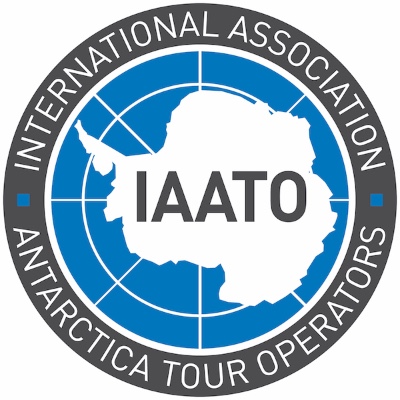Argentinean Antarctic Station Esperanza Another possibility to actually step onto the continent would be a visit to the Argentinean Antarctic Station "Esperanza". The year round station in the Antarctic Sound counts with a small school, as some of the personnel did come with their children to Antarctica. In the immediate vicinity there is a colony of Adélie Penguins.
Antarctic Sound
The passage to the east side of the Antarctic Peninsula traverses Antarctic Sound, which is 30 miles (48 km) long and 7-12 miles (11-19 km) wide and runs northwest-to-southeast. This is where huge tabular icebergs roam. All-white, Black-pupiled, and Black-billed Snow Petrels are likely to be coursing over the scenery, often joined by Pintado Petrels and early in the spring, by Antarctic Petrels streaming south to nesting territories on slopes fringing the Weddell Sea.
Bay of Isles
The magnificent Bay of Isles is studded with numerous islets. Some of them are open for visitation.
Brown Bluff
The spectacular rust-colored promontory on the Tabarin Peninsula, Brown Bluff, is located south of Hope Bay. On its long beach more than 20,000 Adélie penguins and a smaller group of Gentoo Penguins have found their home. There is also a potpourri of Kelp Gulls, Snow Petrels, and Pintado Petrels swirling above.
Cooper Bay
Cooper Bay is at the southeast extremity of the South Georgia where fascinating volcanic rocks towering over small fiords. There is a wealth of wildlife at this site, in a spectacular setting. Chinstrap, Gentoo and Macaroni Penguins dot the tussock slopes and there are plenty of fur seals on the beaches.
Deception Island, South Shetland Islands
Long ago, volcanic pressure on Deception Island resulted in a tremendous eruption that caused the island's peak to explode. The resulting caldera flooded with seawater, creating the unique landmass we may visit. Stark volcanic landscapes wait for us on the inside. Brave souls may don their bathing suits for the unusual opportunity of a swim in the Antarctic, since the waters around Deception Island are usually geo-thermally heated!
Drygalski Fjord & Larsen Harbour
Although Drygalski Fjord´s glaciers have retreated significantly in recent decades, they remain one of the most striking features of this coastline, particularly the Risting and Jenkins Glaciers. A small colony of Weddell seals, South Georgia Pipit, Smaller Burrowing Petrels and Prions may be seen on Larsen Harbour.
Gold Harbour
Gold Harbour offers some of the most spectacular scenery; an amphitheatre of hanging glaciers and vertical cliffs rise straight out of the sea and the towering snow-covered peaks of Mt. Patterson create an unforgettable backdrop to an exceptional abundance of seabirds and seals. The surrounding cliffs of Gold Harbour provide habitat for nesting Light-mantled Sooty Albatrosses, which can often be seen soaring above the beach. There is a large colony of King Penguins and the sandy beach is a favorite haul-out spot for massive southern elephant seals.
Grytviken
Once a thriving whaling station, the ruins of Grytviken stand as a reminder of an era of exploitation that thankfully grows more distant by the day. In Grytviken, another former whaling town, we would also like to invite you for a visit to the most interesting Museum about Natural History and Whaling in the area, as well as to the last resting site of Sir Ernest Shackleton at the nearby graveyard in King Edward cove.
Elsehul
This beautiful little harbor is the only visitor site on the island where colonies of Black-browed and Grey-headed Albatrosses can be viewed from zodiacs within the protection of sheltered inshore waters.
Fortuna Bay & Stromness Bay
Today the whaling station which operated here from 1907 is abandoned and King Penguins as well as seals roam free through the streets. Buildings are occupied by elephant seals and guarded by fierce fur seals.
Half Moon Island, South Shetland Islands
The crescent-shaped island lies in the entrance to Moon Bay between Greenwich and Livingston Islands. There are some excellent hiking opportunities and some truly glorious scenery.
Hydrurga Rocks
This small island group of islets lies east of Two Hummock Island in the Palmer Archipelago. Chinstrap Penguins, Blue-eyed Shags, and Kelp Gulls are confirmed breeders. The island rises to approximately 25 meters above sea level - the views of the northern Gerlache Strait with its steep ice-covered mountains in the backdrop are stunning.
King George Island
The largest of the South Shetland Islands, features colonies of nesting Adélie and Chinstrap Penguins, Kelp Gulls, Blue-eyed Cormorants, Antarctic Terns and Southern Giant Petrels and is home to scientific bases of many different countries. Macaroni, Chinstrap and Gentoo Penguins as well as elephant seals await you at Livingston Island.
Paradise Bay
Perhaps the most aptly named place in the world and we attempt a landing on the continent proper. There are bustling Adélie Penguin (over 100,000 pairs breed here) and Blue-eyed Cormorant colonies on Paulet Island. The Nordenskjöld expedition built a stone survival hut here in 1903. Today its ruins have been taken over by nesting penguins.
Portal Point
Portal Point served as the gateway for a route to the Peninsula plateau. The snow slope from the landing rocks rises steeply toward the plateau. There are large glacial tongues extending down to sea level. These terminate against the sea in high ice cliffs. Nearby Charlotte Bay is often filled with icebergs.
Prion Island
On the tussock-grass covered islet, there is a breeding colony of Wandering Albatross.
Right Whale Bay
A beach formed by black volcanic ashes, home to fur seals, elephant seals and King Penguins amongst other bird species, such as Prions and Giant Petrels.
Salisbury Plain
Salisbury Plain sometimes called the "Serengeti of the South" is a wildlife site without parallel. Several large glaciers provide a dramatic backdrop for the tens of thousands of King Penguins that nest in the tussock grass of this remarkable ecosystem. Elephant and fur seals also abound, as well as Southern Giant Petrels and the occasional wandering Gentoo Penguin.

